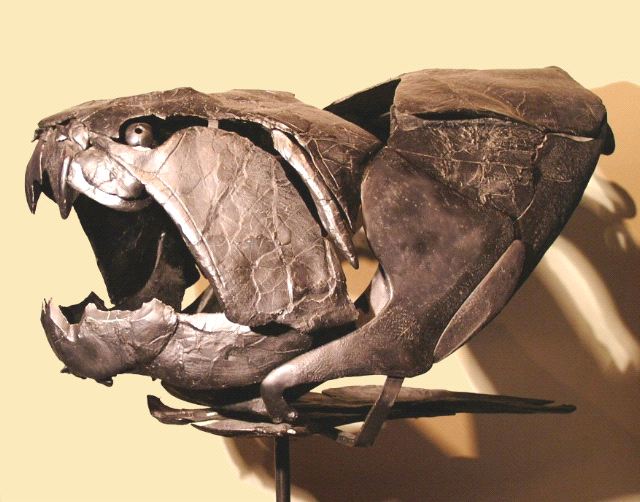Arthrodires
Their name means “jointed neck”, reflecting the fact that mobile joints connecting platy armour covering arthrodire’s head and thorax allowed some vertical movement.
 (56 kb) Powerfully equipped for active swimming and endowed with large jaws lined with teeth or sharp edges, these fish were efficient predators. The group made up nearly two thirds of all placoderms.
(56 kb) Powerfully equipped for active swimming and endowed with large jaws lined with teeth or sharp edges, these fish were efficient predators. The group made up nearly two thirds of all placoderms.
When its jaw opened downward, the upper part of arthrodire’s skull moved upward to maximize gape size and engulf the largest prey possible. A recent study modelled the musculature and jaw movements of Dunkleosteus, an arthrodire fossil found in Ohio. Dunkleosteus was the largest placoderm ever, measuring up to 9 metres long and weighing several tonnes. It could open its mouth extremely quickly, like modern day fish that use suction to capture their prey. When Dunkleosteus closed its mouth, its muscles created an extraordinarily strong bite with a force of about 5,000 newtons! This was the most powerful bite of any fish, and a force equalled only by the famous Tyrannosaurus Rex, a dinosaur that appeared much later.
Arthrodires were not all monsters, with some only reaching a dozen centimetres in length. Miguasha fossils include the arthrodire Plourdosteus, which grew up to a metre long.

 (56 kb) Powerfully equipped for active swimming and endowed with large jaws lined with teeth or sharp edges, these fish were efficient predators. The group made up nearly two thirds of all placoderms.
(56 kb) Powerfully equipped for active swimming and endowed with large jaws lined with teeth or sharp edges, these fish were efficient predators. The group made up nearly two thirds of all placoderms. When its jaw opened downward, the upper part of arthrodire’s skull moved upward to maximize gape size and engulf the largest prey possible. A recent study modelled the musculature and jaw movements of Dunkleosteus, an arthrodire fossil found in Ohio. Dunkleosteus was the largest placoderm ever, measuring up to 9 metres long and weighing several tonnes. It could open its mouth extremely quickly, like modern day fish that use suction to capture their prey. When Dunkleosteus closed its mouth, its muscles created an extraordinarily strong bite with a force of about 5,000 newtons! This was the most powerful bite of any fish, and a force equalled only by the famous Tyrannosaurus Rex, a dinosaur that appeared much later.
Arthrodires were not all monsters, with some only reaching a dozen centimetres in length. Miguasha fossils include the arthrodire Plourdosteus, which grew up to a metre long.
Site map | Feedback | Links | Sources | Credits
Arthrodires
<< Bothriolepis | Plourdosteus >>

Title: Dunkleosteus
Author: Parc national de Miguasha
Sources: Parc national de Miguasha
Year: 2002
Description:
The arthrodire Dunkleosteus from Ohio was one of the giants in Devonian seas. Growing 7 to 9 metres long and equipped with sharp jaws, it was a formidable predator indeed. Plourdosteus – the arthrodire found at Miguasha – was basically a smaller version of Dunkleosteus.


